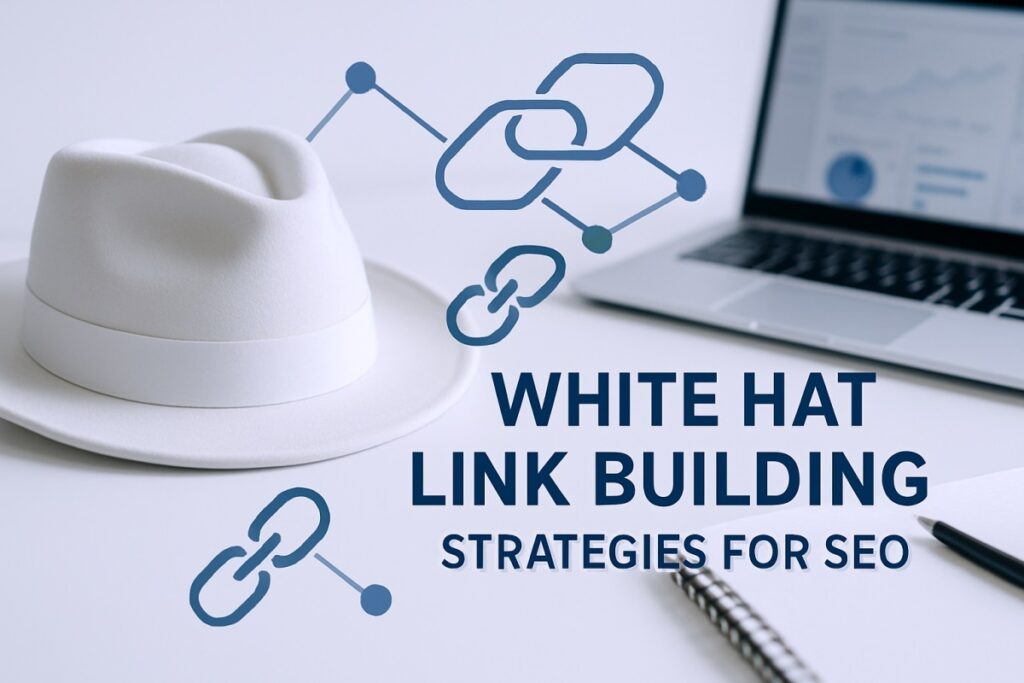Ranking high on Google isn’t just about great content – it’s about authority. And authority comes from backlinks. In 2025, white hat link building is still the safest, most sustainable way to build that authority and earn long-term SEO success. Whether you’re a solo marketer or running a full digital team, mastering ethical link building can be your biggest edge in a highly competitive search landscape.
This guide dives deep into the most effective white hat link building strategies of the year, with practical tips, real-world examples, and tools to help you stay ahead. We’ll also explore key differences between ethical and manipulative tactics, so you know exactly how to protect your site while boosting its visibility.
What is White Hat Link Building?
White hat link building refers to the practice of acquiring backlinks using methods that comply with Google’s Webmaster Guidelines. These strategies emphasize value, transparency, and user experience.
What are white hat backlinks? Simply put, they are links earned through merit, like publishing great content, building relationships, and sharing expertise. Unlike paid or manipulated links, white hat backlinks come from relevant, authoritative sources and reflect your site’s credibility.
Common white hat techniques include outreach, guest blogging, PR campaigns, and resource creation. These efforts take time but lead to stronger rankings and a solid reputation.
White Hat vs Black Hat Link Building
Understanding the contrast between white hat and black hat practices is key to avoiding penalties and building a lasting presence online. While both approaches aim to improve a site’s visibility, they differ in method, ethics, and consequences.
| Criteria | White Hat Link Building | Black Hat Link Building |
| Techniques | Guest blogging, outreach, PR, broken link fixes | Link farms, PBNs (Private Blog Networks), cloaking, automated link schemes |
| Risk Level | Low | High (manual penalties, de-indexing, loss of rankings) |
| Longevity | Sustainable, long-term growth | Unstable, often short-lived boosts |
| Google Compliance | Full compliance with Webmaster Guidelines | Clear violation of search engine policies |
| Ethical Value | Transparent, trust-based tactics | Deceptive, manipulative tactics |
White hat link building focuses on earning backlinks naturally by offering real value – helpful resources, expert content, or partnerships. These methods not only enhance a website’s credibility but also strengthen relationships with industry peers.
In contrast, black hat link building seeks shortcuts. Techniques like cloaking (showing search engines different content than users), paid backlinks from irrelevant or spammy sites, and automated blog commenting are designed to manipulate rankings rather than provide value. While they may offer a temporary boost, Google’s algorithms, especially with frequent core updates, are now sophisticated enough to detect and penalize these tactics swiftly.
The March 2024 Core Update is a prime example. Thousands of websites experienced dramatic ranking losses or were completely removed from the index for relying on manipulative backlink strategies. Recovery is time-consuming and can result in permanent domain reputation damage.
Moreover, black hat techniques often require continuous effort to avoid detection, which paradoxically takes more time and resources over the long term than white hat strategies. Google’s Link Spam Update series since 2022 has progressively improved the detection of paid and spammy links, devaluing them or penalizing the associated sites entirely.
Choosing white hat practices ensures that your link profile remains future-proof and algorithm-resistant. It’s not just about avoiding punishment, it’s about building a brand that search engines trust.
Top White Hat Link Building Strategies With Examples

White hat link building isn’t just about playing by the rules, it’s about outsmarting competitors by delivering genuine value. Below are 10 proven, scalable strategies that are driving results in 2025, with examples and pro tips to make them work for your niche.
1. Guest Blogging on Authority Sites in Your Niche
What it is: Writing articles for reputable blogs or publications in your industry to gain backlinks and exposure.
Why it works: It positions you as an expert while earning editorial links.
Example: A sustainable beauty brand writes a post on “The Future of Clean Skincare” for a wellness site like MindBodyGreen. The post links naturally to a case study on their site.
How to find opportunities:
- Use search operators like “write for us” + your niche
- Analyze competitor backlinks to see where they’ve guest posted (using Ahrefs or SEMrush)
Pro Tip: Personalize your pitch. Editors receive dozens of outreach emails daily—tailor each one with relevant ideas, headlines, and links to past work.
2. Broken Link Building
What it is: Replacing broken (dead) links on other websites with your own relevant content.
Why it works: You help webmasters maintain quality and fix issues while gaining a link in return.
Example: A SaaS company finds a 404 link on a software comparison blog. They offer their updated, in-depth guide as a replacement.
Tools to use:
- Ahrefs Site Explorer (look for 404s in outbound links)
- Check My Links (Chrome extension)
- Screaming Frog for larger audits
Pro Tip: Always match your replacement content to the original topic and offer a short, friendly email: “I noticed a broken link on your article – here’s a working, updated version that might be helpful.”
3. Digital PR & Newsworthy Campaigns
What it is: Creating original data, reports, or angles that appeal to journalists and influencers.
Why it works: Media outlets love unique insights, and you can earn backlinks from high-authority publications.
Example: A cybersecurity firm publishes a “Top Phishing Scams of 2025” report. It’s picked up by Wired and CNET, each linking back to the full report.
Tactics:
- Use surveys, customer data, or industry trends
- Tie your story to a timely or controversial topic
- Submit to PR platforms like HARO, Terkel, Qwoted
Pro Tip: Include visuals like charts or infographics—these increase pickup by 37%, according to Muck Rack’s 2024 State of PR report.
4. Linkable Assets (Resource Hubs, Tools, Guides)
What it is: Creating ultra-valuable content or tools that other websites naturally want to link to.
Why it works: These evergreen assets serve as go-to resources in your industry.
Examples:
- A legal firm creates a “Startup Founder’s Legal Checklist” PDF
- An SEO tool builds a free keyword difficulty calculator
- A B2B SaaS brand curates a “2025 Trends Report” downloadable guide
Promotion channels:
- Reddit communities
- LinkedIn groups
- Outreach to resource roundups or listicles
Pro Tip: Update your linkable assets quarterly to stay current and repromote them regularly.
5. Unlinked Brand Mentions
What it is: Identifying where your brand, product, or founder is mentioned online – but not linked – and requesting the missing backlink.
Why it works: The content already exists, so the conversion rate on outreach is high.
Example: A small ecommerce brand finds an article mentioning their product on a gift guide but without a hyperlink. They reach out and ask nicely for a credit link.
Tools:
- Google Alerts
- BrandMentions
- BuzzSumo’s Mention Tool
Pro Tip: Keep it short and polite: “Thanks for mentioning us! Would you consider linking to our homepage for easier reader access?”
6. Expert Roundups and Collaborative Content
What it is: Involving multiple industry experts in a single piece of content. Contributors are more likely to share and link to content they’re featured in.
Why it works: You get social proof, influencer promotion, and backlinks – all in one move.
Example: A marketing agency publishes “25 Experts Predict the Future of Google AI,” tagging each contributor and encouraging them to share.
Bonus: Reach out to these contributors when you create new content – they’re likely to reciprocate again.
7. Podcast Guesting & Interviews
What it is: Appearing on podcasts in your industry and getting backlinks in episode show notes and podcast websites.
Why it works: Podcast hosts love fresh voices, and backlinks from podcasts are often from DA50+ sites.
Example: A founder of a project management tool is invited on a productivity podcast. The show notes link to their landing page and free trial.
Where to find podcasts:
- Podchaser
- Rephonic
- iTunes category searches
Pro Tip: Create a “speaker bio” page with your previous appearances – it builds credibility and helps you get booked faster.
8. The Skyscraper Technique
What it is: Finding existing content that performs well, creating a better version, then asking the same sites to link to your piece instead.
Why it works: You offer more value to users and publishers than what they’re already linking to.
Example: A B2B company sees a popular “Top CRM Software” post with outdated info. They create a 2025 edition with better visuals and updated data, then reach out to sites linking to the old post.
Pro Tip: Make your version clearly superior – longer, more up-to-date, visually appealing, and full of unique insights.
9. Testimonials and Product Reviews
What it is: Writing testimonials or reviews for products/services you already use, often in exchange for a backlink.
Why it works: Companies love highlighting happy customers and often feature them prominently on their sites.
Example: A digital marketer writes a testimonial for their email automation platform. It’s featured on the vendor’s homepage with a link to the marketer’s website.
Pro Tip: Offer a headshot and job title. Testimonials with photos are 42% more likely to get published.
10. Strategic Partnerships & Co-Marketing
What it is: Partnering with non-competing brands to co-create and promote content that earns mutual backlinks.
Why it works: Shared promotion = greater exposure, and backlinks flow naturally between collaborators.
Example: A content agency teams up with a video studio to create a joint guide on “Building a Content Funnel That Converts.” Both promote it on their blogs and newsletters.
Bonus Ideas:
- Co-host webinars or virtual events
- Joint giveaways or reports
- Content swaps between blogs
11. Data Studies & Surveys
What it is: Publishing original research, polls, or industry-specific data that journalists and bloggers love to reference.
Why it works: Unique data earns organic backlinks from credible sources and positions your brand as a thought leader.
Example: Preply’s “Grandparent Nicknames by State” study was picked up by over 150 publications, including Reader’s Digest and Yahoo.
Tools to use:
- Survey platforms like OnePoll, Pollfish, or Google Forms
- Statista and public data sources for benchmarking
Pro Tip: Visualize your findings using tools like Canva or Datawrapper. Including easy-to-embed charts and graphs can increase your link placement success rate dramatically.
12. Infographics & Visual Storytelling
What it is: Designing shareable infographics that distill dense or trending information into bite-sized visuals.
Why it works: Visuals are easier to understand, more engaging, and highly shareable across blogs and social media.
Example: Resume.io created a “Career Advice from Founders” infographic that earned over 50 backlinks from HR and business blogs.
Pro Tip: Reach out to bloggers who’ve previously shared similar visuals. Use reverse image search to find them, then pitch your updated, higher-quality version.
13. Interactive Tools & Calculators
What it is: Building mini-apps or widgets like cost estimators, diagnostic quizzes, or ROI calculators.
Why it works: They provide utility and keep users engaged – plus they’re frequently cited as sources in listicles or resource pages.
Example: BetterPet’s “Dog Age Calculator” drew 75+ referring domains. Users love and link to tools that solve micro-problems quickly.
Pro Tip: Embed a “Link to this tool” snippet directly on your page, making it easier for others to cite and backlink to your tool.
Tools for White Hat Link Building

Executing a successful white hat link building strategy requires more than solid tactics – it also depends on using the right tools to streamline research, outreach, and tracking. Here are the top tools in 2025 that help white hat practitioners stay ahead of the curve.
Research & Opportunity Discovery
- AhrefsA powerhouse for backlink analysis, content research, and identifying broken links. Use the “Content Explorer” to discover high-performing content and the “Site Explorer” to analyze competitors’ backlink profiles.
- SEMrushOffers backlink audits, keyword research, and outreach suggestions. Their Link Building Tool identifies domains worth targeting based on competitor gaps and keyword intent.
- BuzzSumoGreat for uncovering trending content and linkable asset ideas. You can also see who’s sharing or linking to top-performing pages in your niche.
- Hunter.ioHelps find verified email addresses for outreach. It’s especially useful when scaling personalized campaigns while keeping bounce rates low.
- Google Search OperatorsUse advanced search queries to locate guest post opportunities, resource pages, or unlinked mentions.
Outreach & Relationship Building
- PitchboxA full-scale outreach platform tailored to link building. It supports personalized email campaigns, automated follow-ups, and campaign performance tracking.
- NinjaOutreachCombines influencer prospecting with outreach automation. Ideal for building partnerships with bloggers, journalists, and podcasters.
- MailshakeEnables cold outreach at scale with tools for A/B testing, reply tracking, and automated follow-ups – all while maintaining a human tone.
- LinkedIn Sales NavigatorUseful for identifying and connecting with decision-makers or content managers before pitching via email or direct message.
Tracking & Monitoring
- Google Search ConsoleEssential for tracking new backlinks, identifying lost links, and disavowing harmful ones. It also helps monitor site performance related to earned links.
- Moz Link ExplorerOffers metrics like Domain Authority, Spam Score, and link freshness. Great for ongoing link profile audits.
- BrandMentionsTracks your brand across news, blogs, forums, and social media. Ideal for turning unlinked brand mentions into backlink opportunities.
- HARO (Help a Reporter Out) and TerkelPlatforms that connect subject-matter experts with journalists. A great way to earn high-authority links from credible publications by contributing insights or quotes.
Developing a structured workflow with these tools, research, qualification, outreach, follow-up, and monitoring, can dramatically improve link acquisition efficiency and results. Even small marketing teams can execute enterprise-level strategies with the right software stack and a clear plan.
Conclusion
White hat link building remains the cornerstone of sustainable SEO success in 2025. As search engines continue refining their algorithms and penalizing manipulative tactics more effectively, ethical strategies are not just preferred – they’re essential.
Here’s why white hat link building stands out:
- It builds long-term trust and authority
- It aligns with Google’s guidelines and reduces algorithm risk
- It strengthens your digital reputation and domain relevance
- It generates qualified, organic traffic that converts
Unlike black hat shortcuts, white hat tactics don’t rely on loopholes or automation tricks. They’re rooted in value creation, relationship building, and content quality. While they may take more time to implement, the payoff is lasting visibility and credibility.
Whether you’re managing in-house outreach or partnering with a white hat link building agency, success comes from consistency and strategic execution. And it doesn’t have to break the bank, there are also affordable white hat link building services and tools that offer high ROI without compromising quality.
The most effective path forward is to start small, stay ethical, and scale thoughtfully. Choose a few strategies that align with your brand, invest in quality content, and use the right tools to maintain momentum. Over time, you’ll build not just links, but a defensible, high-authority online presence that supports all your digital growth goals.
